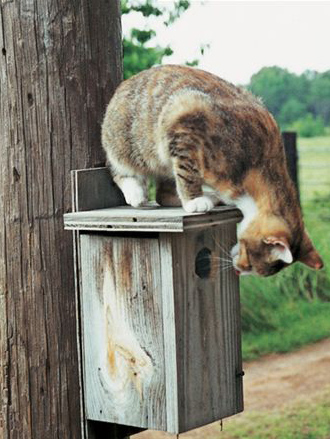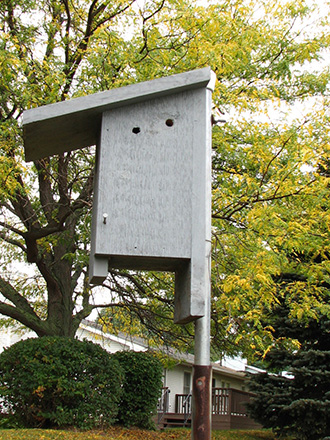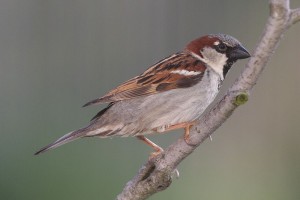How to Handle Emergencies
The bluebird and other cavity nesting birds we provide nest boxes for are susceptible to the many challenges of living in nature as are many species of animals and birds. Predation by other birds and animals, inclement weather, even vandalism, can cause losses of eggs, young and adults.
It is sometimes difficult to assess and help injured or sick birds. Their best help in this are the many licensed Wildlife Rehabilitators around the state. Many are associated with veterinarians and veterinary hospitals; some are listed in the Yellow Pages or can be reached by contacting: NYS Wildlife Rehabilitators at www.dec.ny.gov/animals/83977.html .
In many instances you may be able to “diagnose” and handle the problem yourself. What will prepare you best is your knowledge of the bluebird’s natural history, how and when it lays its eggs, when the young hatch and fledge and what you might normally expect when you monitor your bluebird trail. In other words: Know what is “normal”. Knowing the proper construction of a nest box and where it should be placed may be critical to giving the bluebird the best chance of survival.
Some emergency situations are listed below with suggestions to help you deal with them.
Emergencies are urgent occurrences which you may experience while monitoring nest boxes. If you cannot find your answers here, you may send your inquiries to .
Covered Emergencies Are:
- Abandoned or infertile eggs
- Single parent nests
- Dead nestlings
- Predation
- House sparrows
- Damp, wet, soggy nests
Abandoned or infertile eggs
To determine if eggs are viable, you must know the exact date when incubation started. For a completed clutch, 12-14 days is the normal hatch time, but cold temperatures can extend the incubation time. If you are unsure of the status of the eggs, leave the eggs in the nest and recheck in 5-7 days. If there are only one or two eggs in the nest, observing the presence of more would be evidence that the nest is still active. If the nest has failed, many times bluebirds will either remove the eggs or build a new nest over the top of the old one. First, cause no harm. If it has failed, you can remove the inactive nest with the eggs so the box can be used again. Dispose at a distance from the nest box so as not to attract predators.
Single parent nests
A. Female bluebird found dead and eggs are present:
If you find the female bluebird dead with eggs, consider the nest lost. The male bluebird is not physically able to incubate the eggs as he does not have a brood patch. If you know the exact age of the eggs and that they have indeed been abandoned, you may have some success in placing one egg in another nest which you are certain has eggs of the same age. They may then be adopted and incubated successfully by the female. Placing too many eggs in another bluebird nest will place a dangerous burden on the parents when it comes time to feed the growing nestlings that result.
B. Female bluebird found dead with young in the nest:
This always is a very serious situation with, in most instances, a poor outcome. If the nestlings are older than 5-7 days, male bluebirds, under the right conditions (warm weather, plenty of insects), may be able to successfully raise young by themselves. Nestlings under 10 days of age need brooding at night or during colder temperatures. A wildlife rehabilitator (Department of Environmental Conservation and click on passerine birds) may be of great help in this situation if you cannot find one or two nests which might be able to accept a nestling of the same age. This is difficult because the adoptees will be competition for the young nestlings already in the nest and may cause it to fail compounding an already bad situation.
Orphaned chicks can be transferred to other bluebird nests if the following rules are followed:
- Do not transfer any chicks during inclement weather.
- No more than 5 chicks total in any nest. (The parents can only provide adequate food for a normal sized clutch.)
- Chicks must be matched up closely so they are the same age and size.
Failure to follow all of the above rules could jeopardize the entire nest.
C. Male bluebird found dead with chicks or eggs:
Female bluebirds can incubate, hatch, and raise a brood of nestlings by themselves. Single bluebirds struggle with large broods. Fostering out one or two chicks to another nest can help. Supplying mealworms will help the female with feeding her young.
Dead nestlings
Nestlings can die for various reasons: Abandonment, prolonged cold, lack of food, severe blowfly infestation, and competitor species attack. If you are having a prolonged cold/wet spell, consider putting out mealworms to help the parents feed the babies. Daily/weekly nest checks can help you determine if there is a LOT of blowfly larvae underneath the nest. If there are, remove the nest and replace it with dried grass clippings. To help avoid competing species attacks, don’t allow house sparrows to nest in your boxes and try to place your boxes away from trees to discourage wrens. Remove the dead nestlings, if they are all dead, and then remove the nest. The bluebirds may re-nest. (Download the pdf Blow Flies and Bluebirds.)
Predation
Try to determine what the predator is: Nest torn up and contents destroyed: Probable cause – cat or raccoon reaching in. No signs of nest damage but eggs gone or on ground: Probable cause – snake or bird (house wren or house sparrow removing eggs). Opening enlarged and roughened: Probable cause – woodpecker. Once you determine a cause, you can take measures to prevent it from happening again.
Nesting boxes should be placed in low grass areas away from heavy cover which could hide predators. They should be mounted on a smooth metal pole at least 5 feet above ground. Cone shaped predator guards can be mounted to the poles to prevent climbing predators. Grease applied to the poles to prevent a climbing predator from getting a grip will also work 90% of the time. A good predator guard applied to a pole or post is one of the best ways to prevent raccoons or cats from climbing to your nest box. Nest boxes should be placed on stand-alone poles or posts and never attached to a fence post or tree that a predator can climb up on. And, the higher you can place the nest box, and still monitor without climbing a ladder, the better. Cats have been known to jump up to 7 feet to the top of a nest box. (Download the pdf Predator Control)
 |

|
House Sparrows

If you have house sparrows competing with bluebirds, you need to evaluate your nest box placement. House sparrows are extremely territorial birds that will persist in an area until removed or you reposition your bluebird nesting boxes to an area away from them. Disappointing information, but house sparrows are usually found in habitat that should not be selected for bluebird nesting boxes.
House sparrows are an alien species. Their nests, eggs, young and adults are not protected by state or federal laws. They have displaced many native species including bluebirds. The NYSBS has traps available for capturing and removing house sparrows from nest boxes. (Download the pdf Order By Mail.) Please do not let house sparrows nest in your nest boxes. Dead or alive trapped house sparrows can be given to rehab centers. (See our FAQ section on House Sparrows, Download the pdf Residential House Sparrow Advisory and download the pdf House Sparrow Control.)
Damp, Wet, Soggy Nests after a Rain
If the nest is empty, you can try your hand at nest building after removing the nest and inspecting the nest box for position – Is it facing the direction from which most rainy weather comes? If so, it needs to be repositioned. Also check construction of the nest box. Remember – a properly constructed nest box should have tightly fitted sides, bottom and top. This is a very important part of placing a nest box out for bluebirds – or any bird for that matter. When there are eggs or young in the nest, this is critical as the dampness could contribute to their deaths in colder weather and in warmer weather act as a pathway for disease. (Download the pdf NYSBS Nestbox.) If the nest is damp with eggs or young in it, carefully remove the damp nest with the eggs or young, then repair the box if necessary and then from similar dried grasses form a nest and place it in the box and replace the eggs or young. Make some arrangement to keep them warm and dry while you quickly make the new nest. A warm towel with a hot water bottle wrapped in it would work. Work as quickly as possible to get them back into their nest box. http://www.sialis.org/nestchange.htm
